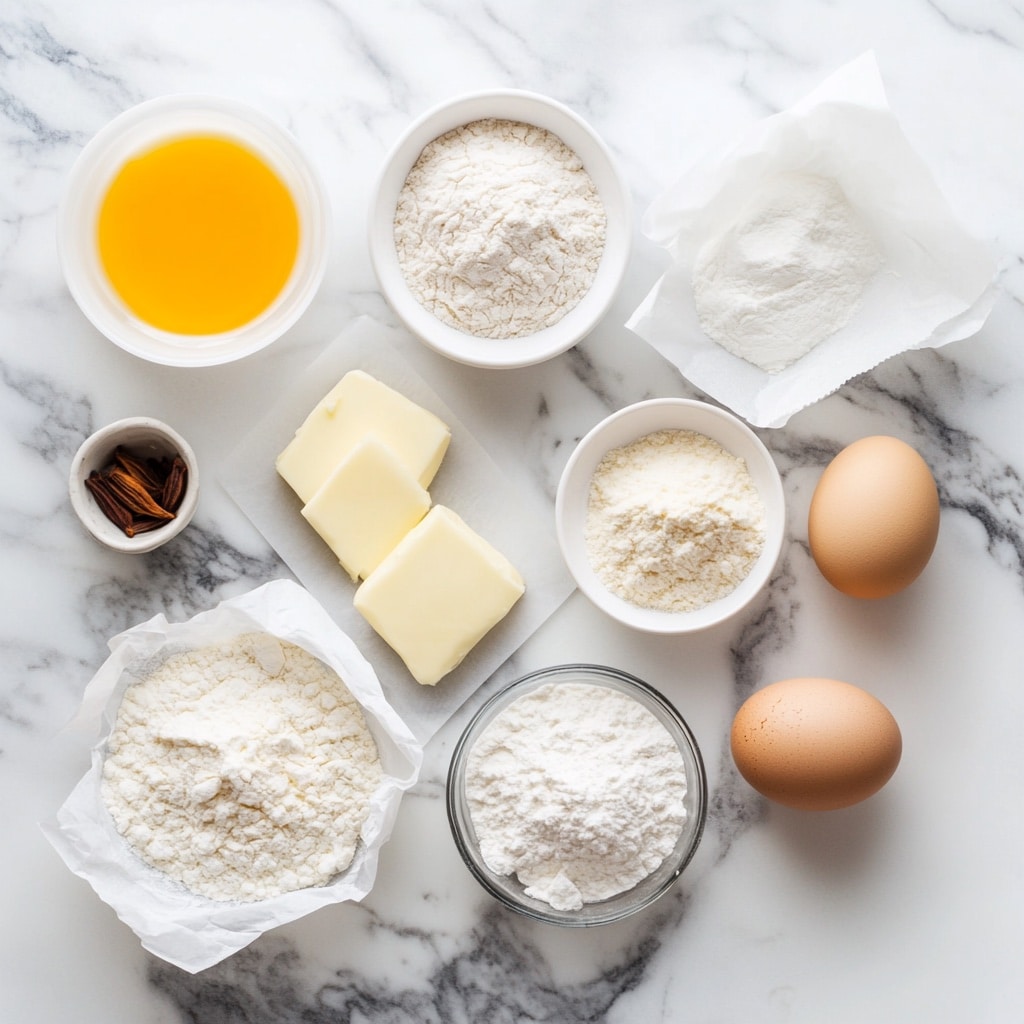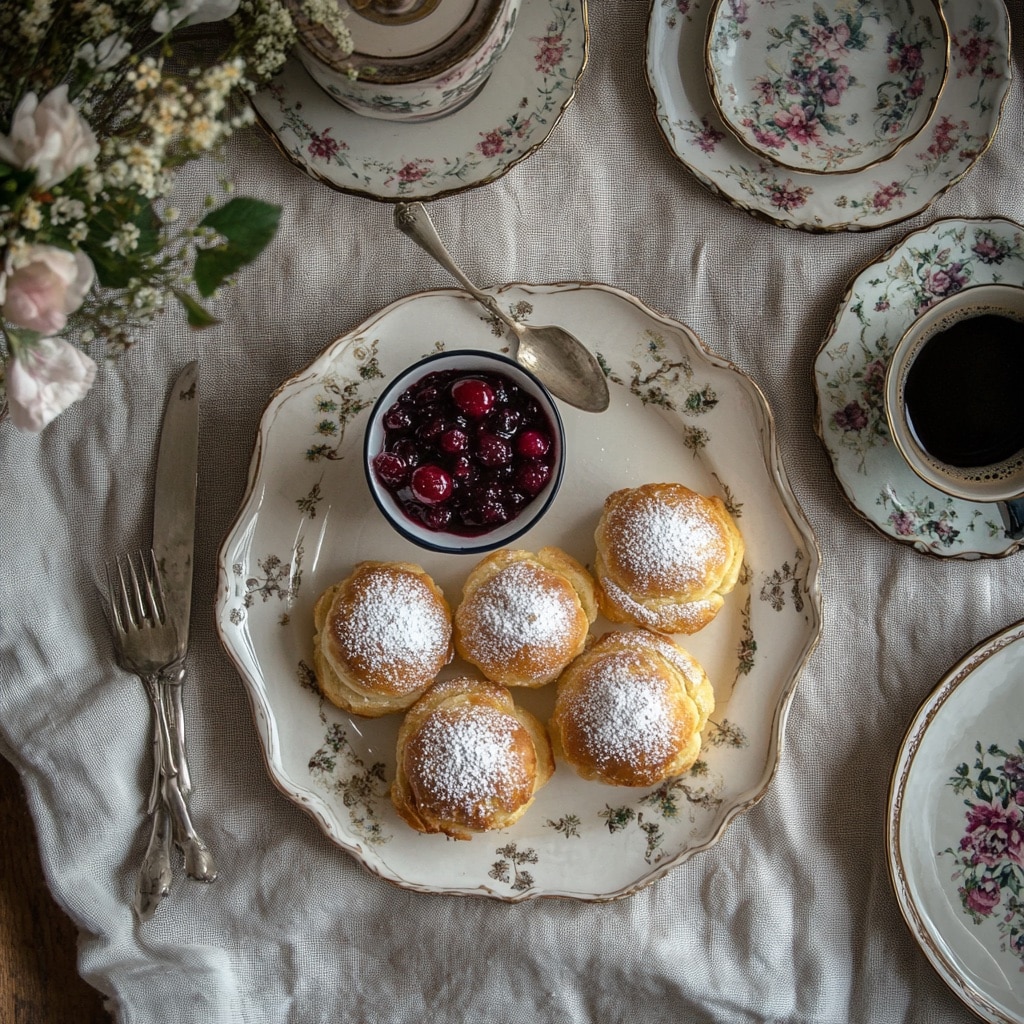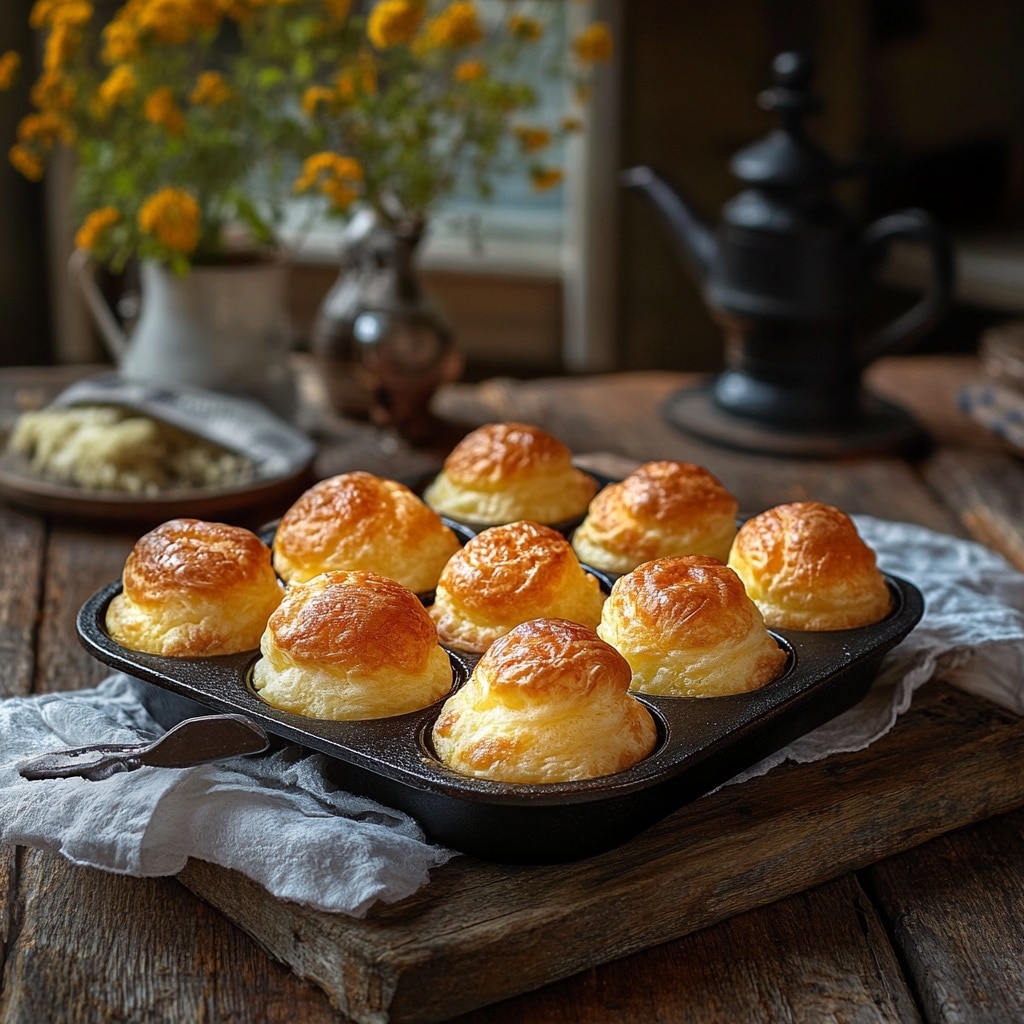Table of Contents
introduction
When Butter Met Curiosity
One rainy afternoon, I stood in my kitchen with a whisk in hand and zero plan, just leftover eggs, a half-stick of butter, and a mood that craved warmth. My mom’s voice came back to me, telling stories of a French pastry she called “nun’s puffs.” I’d never made them before, but the name stuck with me like flour on an apron. I decided to get hands-on and give it my all.
The dough was strange at first. It didn’t look like anything I was used to, thick and shiny, but loose. I spooned it into a muffin pan anyway, whispered a little prayer, and hoped for the best. Twenty-five minutes later, I pulled out golden, puffed clouds that smelled like the best parts of childhood: butter, warmth, and adventure. They deflated slightly, I had peeked too early, but their texture and flavor were unforgettable.
Since that first batch, I’ve made this nun’s puffs recipe dozens of times. It’s my go-to when brunch needs a touch of charm or when I want to serve something that looks fancier than it is. You don’t need special tools or techniques. Just heat, mix, and bake. These little pastries will win you over, and yes, they go amazingly with my easy milk chocolate mousse for dessert.
Why the Name “Nun’s Puffs” Stuck Around
The original French name is pets de nonne, which literally translates to “nun’s farts”, no joke. It’s said to reflect their light, airy texture and the gentle pop they make when baked just right. Over time, the name softened into “nun’s puffs,” and the recipe traveled from old European kitchens to American hearths, thanks to convents and community cookbooks.
But this isn’t just a story of quirky naming. The nun’s puffs recipe reflects the beauty of old-world baking: resourceful, simple, and totally satisfying. You don’t fill them like cream puffs. You don’t frost them. They rise on steam and a little patience, then crisp into bite-sized perfection. If you’ve never tried them, now’s the time. And if you’ve had a failed batch before, stick with me, I’ll help you get it right.
Print
Nun’s Puffs Recipe: Foolproof Method That Never Fails (2025 Guide)
- Total Time: 35 mins
- Yield: 12 puffs 1x
- Diet: Vegetarian
Description
A classic nun’s puffs recipe that’s buttery, airy, and easy to make with simple ingredients. Perfect for breakfast, brunch, or dessert.
Ingredients
1/2 cup all-purpose flour
1/2 cup whole milk
1/4 cup unsalted butter
2 large eggs (room temp)
1/2 tsp vanilla extract (optional)
Granulated sugar (optional, for dusting)
Instructions
1. Preheat oven to 375°F. Grease a 12-cup muffin pan.
2. In a saucepan, heat milk and butter until simmering.
3. Add flour all at once. Stir until dough forms and pulls away from the sides.
4. Remove from heat. Cool slightly for 5 minutes.
5. Beat in eggs one at a time until glossy.
6. Spoon dough evenly into muffin cups, halfway full.
7. Bake for 25–30 minutes until golden and puffed.
8. Cool on wire rack. Serve warm or store.
Notes
Do not open the oven while baking — this can cause collapse.
Best served fresh, but reheats well in the oven.
Add toppings like honey, powdered sugar, or cheese to customize.
- Prep Time: 10 mins
- Cook Time: 25 mins
- Category: Pastry
- Method: Baking
- Cuisine: French-American
Nutrition
- Serving Size: 1 puff
- Calories: 92
- Sugar: 1g
- Sodium: 64mg
- Fat: 6g
- Saturated Fat: 3.5g
- Unsaturated Fat: 2g
- Trans Fat: 0g
- Carbohydrates: 6g
- Fiber: 0g
- Protein: 2g
- Cholesterol: 47mg
Ingredients & Prep Made Easy
Start with the Basics in Your Kitchen
One of the reasons this nun’s puffs recipe is so timeless is because it asks for very little, and delivers so much. You don’t need special flour, fancy tools, or even a mixer. If you’ve got a saucepan, a spoon, and a muffin pan, you’re ready to go.
Here’s a look at the ingredients you’ll need:
Ingredients for Nun’s Puffs (12 puffs):
- All-purpose flour – 1/2 cup
- Whole milk – 1/2 cup
- Unsalted butter – 1/4 cup (that’s half a stick)
- Eggs – 2 large, at room temperature
- Vanilla extract – 1/2 teaspoon (optional, but adds flavor)
- Granulated sugar – for sprinkling or dusting (optional)
You probably already have these in your pantry, which makes this one of the easiest pastries to try even on a whim. No extra trip to the store required. If you’ve made something like my Amok curry recipe, this will feel like child’s play in comparison.

Making the Dough: Step-by-Step and Stress-Free
The method here is based on classic choux pastry, but with none of the stress. This version of the nun’s puffs recipe is straightforward and forgiving, no piping bags, no shaping, just stir and bake.
Steps to make the dough:
- Preheat your oven to 375°F. Lightly grease a 12-cup muffin pan.
- In a saucepan, add the milk and butter. Heat gently until the butter melts and the mixture just begins to simmer.
- Once simmering, add all the flour in one go. Stir quickly with a wooden spoon. It’ll look lumpy at first, but keep stirring until it pulls together into a dough and leaves the sides of the pan.
- Take it off the heat and let it cool for a few minutes, just long enough so the eggs don’t cook when added.
- Beat in the eggs one at a time. Stir hard after each egg until smooth. The dough will become glossy and thick.
- Spoon the dough into the muffin cups. Fill each one halfway to leave room for puffing.
- Bake for 25 to 30 minutes without opening the oven. You’ll know they’re ready when they’ve puffed up and turned deep golden brown.
Let them sit for a minute before removing. A crisp outer shell with a hollow inside is exactly what you want, they’ll settle a bit as they cool, and that’s completely normal.
Mastering the Puff
Baking vs Frying: Which Delivers the Best Nun’s Puffs?
When you’re testing out any nun’s puffs recipe, you’ll quickly face the choice: stick with baking, or go classic and fry them?
Baking remains the simplest way to get reliable results. It’s tidy, consistent, and produces a puff that’s golden on the outside with an airy middle. This method, the foundation of this recipe, is ideal whether you’re preparing them for breakfast or adding them to a sweet tray.
Frying, however, introduces a new texture and a deeper flavor. You’ll scoop spoonfuls of dough into hot oil, where they puff, turn, and finish with a warm, golden shell. These puffs come out with a tender bite and a slightly richer finish, not unlike an old-school doughnut. If you’re feeling bold, it’s a satisfying twist to try after you’ve mastered the oven version.
Still, I suggest starting with the baked nun’s puffs recipe first. It’s dependable and offers that signature crisp-tender combo. Later, when you’re confident, come back and give frying a shot.
The Secrets Behind the Perfect Rise
Let’s talk about the puff. The tall, hollow lift that makes these pastries so charming is powered by one thing: steam.
The magic behind this nun’s puffs recipe isn’t baking powder or yeast. It’s the rapid heat turning moisture from the milk and butter into steam, which forces the dough upward and outward. The eggs give it strength and elasticity, locking in that height as it sets.
Here’s how to set yourself up for success:
- Use eggs that aren’t cold – chilled eggs can affect how smoothly the dough incorporates and may reduce rise.
- Avoid opening the oven too soon – even a small drop in heat can cause the puffs to collapse before their structure sets.
- Don’t underbake – the golden color isn’t just for looks. It means they’re firm and crisp enough to hold shape.
- Stick with all-purpose flour – it has the right gluten level to hold steam but still create tenderness.
When everything goes right, you’ll hear a subtle crackling as they cool. That sound means you’ve nailed it.
Troubleshooting Nun’s Puffs
Why Your Nun’s Puffs Go Flat
There’s nothing more frustrating than opening the oven and seeing your golden pastries collapse like popped balloons. It happens to the best of us, especially when learning how to work with a delicate recipe like this one. Luckily, most issues that affect this nun’s puffs recipe come down to a few small but fixable mistakes.
Here’s what usually causes flat, sad-looking puffs:
- Opening the oven door too early. It’s tempting, but the sudden temperature drop prevents the outer crust from setting. Keep that door closed until the final 2–3 minutes.
- Underbaking. Even if they look puffed and golden, they need time to firm up on the inside. Always wait until they’re deep golden brown before pulling them out.
- Improper egg incorporation. Adding cold eggs or mixing too aggressively can break the dough’s structure. Use room-temperature eggs and stir until smooth and glossy.
If your first try isn’t perfect, don’t worry. Every oven is a little different. But once you understand how to work with the dough, your nun’s puffs will come out looking like they belong on a bakery tray.
How to Avoid Common Choux Mistakes
Because this nun’s puffs recipe is based on choux dough, the same techniques apply as if you were making cream puffs or éclairs, only easier.
These are the most common pitfalls:
- Using the wrong flour. All-purpose flour works best here. Bread flour is too strong and won’t create that light interior.
- Skipping the cooling step. If you don’t let the cooked flour mixture cool slightly before adding eggs, you risk scrambling them.
- Not drying the dough enough. After adding the flour, it needs to cook for a minute or two to remove excess moisture. That steam is your lift, but too much liquid will prevent rising.
Stick to the fundamentals and monitor your dough’s consistency, you want a thick, elastic batter that holds its shape when scooped. If it looks watery, give it a moment to rest. If it’s too dense, you may have overcooked it or added the flour too slowly.
You’ll know you’ve nailed this nun’s puffs recipe when you see a batch rise evenly, develop a crisp shell, and settle into that classic hollow center ready to be dusted, filled, or devoured as-is.
Serving Ideas & Pairings
Sweet, Savory & Surprisingly Versatile
The beauty of this nun’s puffs recipe lies not just in how easy it is to make, but in how versatile the final result can be. Once they come out of the oven golden and airy, you’ve got a blank canvas ready for anything, sweet, savory, or even filled.
Here are a few favorite serving ideas that will turn these little pastries into a full-on experience:
Sweet Toppings:
- A light dusting of powdered sugar never goes out of style.
- For an added touch of richness, spoon over a ribbon of spiced honey or cinnamon-swirled syrup.
- Drizzle with warm chocolate, then top with a pinch of sea salt or finely chopped almonds.
- Plate with soft whipped cream and a bowl of fresh seasonal fruit for a light finish.
Savory Twists:
- Fold in some shredded cheese and dried herbs to the dough for a subtle savory base.
- Slice the puffs open and fill with herbed goat cheese and a spoonful of hot pepper jelly.
- Brush warm puffs with garlic-infused butter or serve with whipped cream cheese for brunch.
What makes this nun’s puffs recipe such a gem is how well it fits into just about any course. Whether it’s brunch, tea time, or a creative side at dinner, these pastries blend in beautifully.

Perfect Pairings for Every Occasion
Nun’s puffs are ideal for pairing with a variety of meals and drinks. Their delicate structure and light flavor mean they play well with others, especially contrasting textures and bold additions.
Here are some go-to pairings:
- Strong coffee or espresso – Their texture and subtle richness balance bold brews.
- Hot chocolate – Add a puff to a dessert plate for cozy comfort.
- Fruit preserves – Try fig, raspberry, or citrus jams to add brightness.
- Soft desserts – These puffs are made for scooping rich dishes like my easy milk chocolate mousse.
Looking for something offbeat? Serve them alongside a bold dish like Amok curry, the buttery puff plays wonderfully with spicy heat.
Storing & Reheating Nun’s Puffs
Should You Refrigerate Cream Puffs or Nun’s Puffs?
A question I get all the time is whether you should refrigerate your puffs, and the answer depends on how soon you’re planning to eat them.
For this nun’s puffs recipe, the best texture is always right out of the oven: crisp on the outside, hollow and airy inside. But if you do need to store leftovers, here’s the best way to keep them from turning soggy.
Short-Term Storage (Same Day):
Leave the puffs uncovered at room temperature for up to 6 hours. If you cover them too soon, they’ll steam themselves and lose their crunch.
Overnight Storage:
Place them in a paper bag or wrap loosely in parchment and store in a sealed container. Avoid the fridge, the cold will flatten the puffs and ruin their crispness.
Freezing:
Yes, you can freeze them. Let them cool fully, then arrange them flat without stacking in a freezer-safe dish. When you reheat them later, they’ll puff back up nicely with the right method.
This protects the delicate structure that makes this nun’s puffs recipe so successful. Airy pastries rely on dry storage and gentle heat to stay light and crisp.
How to Reheat Without Losing the Puff
Reheating can either restore that warm, fresh texture, or make a soggy mess. The key is dry, even heat and a little patience.
Here’s my go-to method:
- Preheat your oven to 300°F (150°C).
- Set the puffs on a sheet pan lined with parchment paper or a silicone mat.
- Warm them for 8 to 10 minutes, until they’re crisp again and heated through.
- Avoid microwaving. It traps steam and softens the outer crust almost instantly.
If you’ve stored them properly, you’ll end up with nearly the same crisp, airy texture you started with. And if you want to give them new life, dust with cinnamon sugar or brush with a flavored glaze just before serving.
With a little planning, this nun’s puffs recipe can go beyond just fresh-baked, it can become your anytime pastry, delicious even the next day.
Flour Talk – Choosing Right
What Is the Best Flour for This Nun’s Puffs Recipe?
Flour might seem like a small decision, but it plays a major role in how well your nun’s puffs recipe turns out. The type of flour you use affects structure, puff, texture, and even how hollow the center gets.
For the perfect puff every time, all-purpose flour is the best choice. It has just the right protein content to create structure without making the dough too dense. This balance allows the steam to expand the dough into a golden shell, while still keeping the inside light and airy, exactly what you want from any good nun’s puffs recipe.
Some bakers experiment with bread flour because of its higher protein levels, but that can work against you here. With extra protein comes increased gluten formation, and that added tension in the dough may prevent steam from expanding it fully. The result? Dense or flat pastries, not ideal for this style of puff.
Avoid cake flour too. It’s too soft and delicate to hold the structure needed for this particular nun’s puffs recipe, even though it might sound like a good match for a light pastry. Without enough support from the flour, your puffs might rise briefly but collapse shortly after.
Why It Matters for Rise, Texture & Success
Getting the right rise in your nun’s puffs recipe isn’t just about eggs and heat. Flour doesn’t make a fuss, but it’s what holds everything together. It helps trap the steam that gives the puff its signature height and hollow center.
Using all-purpose flour also helps the dough handle the mixing phase more gracefully. When you’re incorporating eggs, you want the flour structure to hold together without breaking down. All-purpose gives you that flexibility.
If you’ve tried making this nun’s puffs recipe before and had problems with sinking or gummy centers, double-check your flour. That small bag might be the biggest difference between a good batch and a perfect one.
Once you’ve locked in the right flour, everything else falls into place. Your dough will shine, your puffs will rise beautifully, and you’ll start getting consistent, bakery-style results from your own kitchen.
Final Tips for Foolproof Nun’s Puffs
Tiny Tweaks That Make a Big Difference
Even though this nun’s puffs recipe is one of the easiest pastries you’ll ever make, a few extra tricks can guarantee success every time. These aren’t dramatic changes, just subtle habits that transform a decent batch into a flawless one.
First, always measure your ingredients with precision. This is especially important for flour. A little too much, and your dough will be stiff. A little too little, and it won’t hold its shape during baking.
Second, when cooking the milk, butter, and flour mixture, make sure it forms a clean dough ball that pulls away from the pan. This is the foundation of your puff. Don’t rush it.
Also, don’t skip the cooling step before adding eggs. If you’re too quick, the eggs will cook in the pan, and that will ruin the texture. This small pause makes a huge difference in how well your nun’s puffs recipe performs.
And finally, trust the oven. Let the puffs rise and brown fully. They need that high heat and uninterrupted baking time to form the crisp shell and hollow interior that define this classic recipe.
Why This Nun’s Puffs Recipe Just Works
There’s a reason this particular nun’s puffs recipe has become a favorite on my site. It’s simple, it’s flexible, and it works. It doesn’t require piping bags or pastry experience. You don’t even need a mixer. It’s a recipe rooted in old-school kitchen wisdom, use what you have, make it from scratch, and enjoy the result.
This recipe delivers results that look and taste far more advanced than the process suggests. That’s what makes it so fun to share. Friends always think I’ve spent hours baking when the truth is, these puffs come together in under 45 minutes, start to finish.
Whether you’re a first-time baker or a busy home cook looking for a no-fail crowd-pleaser, this nun’s puffs recipe is one to bookmark. You’ll return to it again and again, not just for its ease, but because they’re that good.
And once you get the hang of it? You’ll start playing with flavors, fillings, and even savory spins without hesitation. The base is that reliable. All you need is a little butter, flour, and a whisk.
Conclusion: Why This Nun’s Puffs Recipe Deserves a Spot in Your Kitchen
The best recipes are the ones you return to, the ones that feel as good to make as they do to serve. This nun’s puffs recipe is exactly that. It’s built from pantry basics, yet it transforms into something golden, light, and bakery-worthy. Whether you’re a weekend baker or a busy home cook grabbing 30 minutes to make something joyful, these puffs check every box.
They’re simple, yes. But they’re also elegant. They impress without stress. And they carry with them generations of kitchen wisdom, passed down from old French convents to modern family tables, now yours.
And once you master this easy, versatile nun’s puffs recipe, you’ll start seeing just how adaptable it is: savory herbs, sweet drizzles, fillings, or no fillings. No matter the variation, they’re reliable, delicious, and deeply satisfying. So preheat that oven. Whisk the eggs. And bake something that feels like a win.
and for more recipes follow us on pinterest
FAQ: Answers to Common Questions About the Nun’s Puffs Recipe
Why are they called nun’s puffs?
The name “nun’s puffs” comes from a whimsical French phrase, pets de nonne, which literally translates to “nun’s farts.” While that might sound odd today, it was a lighthearted name for airy, hollow pastries enjoyed in French convent kitchens. The recipe later evolved and became popular in American home baking. This modern nun’s puffs recipe keeps the humor in the name but focuses on flavor and simplicity.
What is the common problem in making cream puffs?
The most common issue is deflation, cream puffs that rise but then collapse. This is usually caused by opening the oven too early or underbaking. Since nun’s puffs are closely related in technique, the same mistakes can apply. That’s why in this nun’s puffs recipe, we bake until deep golden and never open the oven door mid-bake.
Should you refrigerate cream puffs?
If they’re filled with cream or custard, then yes, refrigeration is necessary. But for unfilled puffs like those in this nun’s puffs recipe, refrigeration can ruin the texture. They store better at room temperature or frozen and reheated as needed.
How do you keep cream puffs from getting soggy?
Always let them cool completely before storing. For both cream puffs and this nun’s puffs recipe, store them in a dry, uncovered environment short-term. Long-term? Freeze and reheat in the oven to revive crispness. Avoid plastic wrap or sealed containers unless using a dry layer like parchment.
Why do my cream puffs go flat when I take them out of the oven?
It likely means they weren’t fully baked. The outer shell needs to set completely to hold shape. In this nun’s puffs recipe, baking until a rich golden brown ensures the puffs keep their structure after cooling. Also, avoid under-mixing or rushing the cooking of the dough base.
What is the best flour for choux pastry?
All-purpose flour is your best friend here. It has the ideal protein content to provide structure without creating a heavy dough. That’s exactly why this nun’s puffs recipe recommends it, it delivers consistent puff and a beautiful, tender finish.

